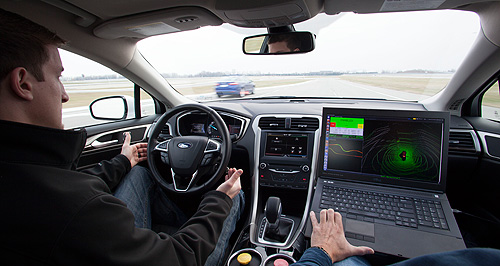Make / Model Search
News - FordAutonomous vehicle benefits far outweigh risks: FordFuturama: Sheryl Connelly (left) predicts that Ford will need to adapt to the changing attitudes and needs of the consumer to be able to thrive in a future where the role of an automobile will be drastically different. Ford expects self-driving teething problems, but tech still safer than human drivers30 Mar 2017 By TUNG NGUYEN FULLY autonomous vehicles are expected to hit the market sometime over the next three years, but many details including regulations, ethics and insurance still need to be ironed out before self-driving vehicles hit the streets, according to Ford's in-house futurist Sheryl Connelly. When asked by GoAuto at the Future with Ford presentation in Melbourne what would happen when an autonomous vehicle makes a mistake and causes an accident, Ms Connelly said public perception should not be swayed by the inevitable teething problems of the new technology. “Planes crash and I still get on them,” she said. “Rollercoasters fail, people still ride them. Boats sink and we still ride them. And so I think human nature is such that we will always balance benefits and risks… we are advancing this technology because we believe the benefits outweigh the risks. “When you think about all the human error that happens on the road today, the distractions that we have on a daily basis – the inexperienced drivers blending with the experienced, blending with the drivers who are sleepy – this should eliminate a lot of that. “So I think we wouldn’t be pursuing it if we didn’t think it would be a safer option, in the right context, but we are also not naive enough to think that there won’t be some trials or lessons to learn along the way.” Ford has plans to bring its first autonomous vehicle to market in 2021, likely in a commercial or ride-hailing capacity, but the hurdles to still overcome incorporate government, regulations, insurance, ethics and more. Ms Connelly explained that self-driving technology would not suddenly pop-up in markets around the world overnight, but would likely appear in areas more willing to embrace a pioneering mentality. “So we haven’t exactly declared where it will take place and it is, you know lots of moving parts, but I like to think we’re still putting the puzzle together and we’re not putting the puzzle together by ourselves,” she said. “Those cities, those industries like insurance, governing bodies, regulation, the lawyers, IT experts, data privacy experts, they’re all part of the conversation too and so my guess is that, wherever we land, is where we will be able to deliver on all those components in the optimal environment.” Ms Connelly also revealed that Ford has been working closely with the US city of San Francisco, not only for autonomous vehicle regulations, but for a wider adoption of Ford’s emerging mobility solutions. “So right now one of our closest partners is the city of San Francisco,” she said. “I think this is probably an indicator of how differently we’re doing business, because when we talk about our customers of the future, they’re not just individuals like us, we say our future customer is the city. “So we have to look at that whole city and say ‘OK San Francisco, what are your hopes, dreams and aspirations for the people that live here? How do you think you can improve their quality of living? How does that translate to mobility? What role can we play in that? And how can we partner with you to help you achieve it?’“So, I imagine if you took that conversation somewhere else in the world, it would be different, you know it would be more contextually driven, and there the challenges go. “We don’t think there will be a one size fits all solution, and probably just as important, we don’t think the solution you opt into will be the same every day, I think it will adjust accordingly.” Policies enacted by California could form the basis for widespread autonomous vehicle adoption, with the US state home to about 27 different companies already testing self-driving technologies. California is also home to a large public electronic vehicle (EV) charging network and incentivises the purchase of emissions-free vehicles and hybrids.  Read more |
Click to shareFord articlesResearch Ford Motor industry news |












Facebook Twitter Instagram